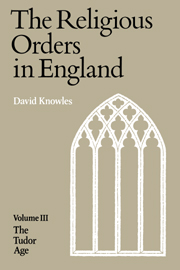Book contents
- Frontmatter
- Contents
- Preface
- List of Abbreviations
- Part One The Tudor Scene
- Part Two The Gathering Storm
- Part Three Suppression and Dissolution
- Chap. XVI Before the Dissolution
- Chap. XVII The end of the Observants
- Chap. XVIII Syon
- Chap. XIX The London Charterhouse and its sister houses
- Chap. XX The economy of the monasteries in 1535
- Chap. XXI Servants, almsgiving and corrodians
- Chap. XXII The visitation of 1535–6
- Chap. XXIII The Act of Suppression and the case for the defence
- Chap. XXIV The dissolution of the lesser houses
- Chap. XXV The Northern Rising
- Chap. XXVI The last phase
- Chap. XXVII The attack on the greater houses
- Chap. XXVIII The suppression of the friars
- Chap. XXIX The cankered hearts
- Chap. XXX The transformation of the buildings
- Chap. XXXI The new cathedrals and colleges
- Chap. XXXII The disposal of the lands
- Chap. XXXIII The treatment of the dispossessed
- Part Four Reaction and Survival
- Appendix I Sir Thomas More's letter ‘to a monk’
- Appendix II Religious houses suppressed by Cardinal Wolsey
- Appendix III The witness of the Carthusians
- Appendix IV Houses with incomes exceeding £1000 in the Valor Ecclesiasticus
- Appendix V The sacrist of Beauvale
- Appendix VI Itinerary of the visitors, 1535–6
- Appendix VII The commissioners for the survey of the Lesser Houses in 1536
- Appendix VIII The conflict of evidence on the monasteries
- Appendix IX The last abbots of Colchester, Reading and Glastonbury
- Appendix X Regulars as bishops
- Bibliography
- Index
Chap. XXXII - The disposal of the lands
Published online by Cambridge University Press: 08 January 2010
- Frontmatter
- Contents
- Preface
- List of Abbreviations
- Part One The Tudor Scene
- Part Two The Gathering Storm
- Part Three Suppression and Dissolution
- Chap. XVI Before the Dissolution
- Chap. XVII The end of the Observants
- Chap. XVIII Syon
- Chap. XIX The London Charterhouse and its sister houses
- Chap. XX The economy of the monasteries in 1535
- Chap. XXI Servants, almsgiving and corrodians
- Chap. XXII The visitation of 1535–6
- Chap. XXIII The Act of Suppression and the case for the defence
- Chap. XXIV The dissolution of the lesser houses
- Chap. XXV The Northern Rising
- Chap. XXVI The last phase
- Chap. XXVII The attack on the greater houses
- Chap. XXVIII The suppression of the friars
- Chap. XXIX The cankered hearts
- Chap. XXX The transformation of the buildings
- Chap. XXXI The new cathedrals and colleges
- Chap. XXXII The disposal of the lands
- Chap. XXXIII The treatment of the dispossessed
- Part Four Reaction and Survival
- Appendix I Sir Thomas More's letter ‘to a monk’
- Appendix II Religious houses suppressed by Cardinal Wolsey
- Appendix III The witness of the Carthusians
- Appendix IV Houses with incomes exceeding £1000 in the Valor Ecclesiasticus
- Appendix V The sacrist of Beauvale
- Appendix VI Itinerary of the visitors, 1535–6
- Appendix VII The commissioners for the survey of the Lesser Houses in 1536
- Appendix VIII The conflict of evidence on the monasteries
- Appendix IX The last abbots of Colchester, Reading and Glastonbury
- Appendix X Regulars as bishops
- Bibliography
- Index
Summary
The Act of March 1536, which provided for the suppression of the lesser monasteries, was accompanied by another, which erected a ‘courte of Thaugmentacions of the Revenues of the Kinges Crowne’ to conduct the business of suppression and to administer the former monastic property. The responsibilities of the new court were greatly increased by the operation of the attainders and surrenders from 1537 onwards, which were confirmed by the Act of May 1539, and they received still further additions in 1540 and 1545, when the lands of the Knights of St John and of the non-academic colleges were confiscated.
The new court, the equivalent of a new ‘ministry’ in a modern scheme of government, was an extension of the administrative revolution which Cromwell had initiated, and was framed after the pattern of the existing court of the Duchy of Lancaster. It was controlled in London by a chancellor, Sir Richard Rich, the solicitor-general, and by a treasurer, Sir Thomas Pope, who was later to found Trinity College, Oxford; they were assisted by an attorney and a solicitor, and the work in the country was carried out by seventeen particular receivers, each allotted to a specified region, and ten auditors, each associated with one or more of the receivers. The salaries of all were to be on a generous scale, and the opportunities for advancing private fortunes were obviously promising.
- Type
- Chapter
- Information
- The Religious Orders in England , pp. 393 - 401Publisher: Cambridge University PressPrint publication year: 1979



